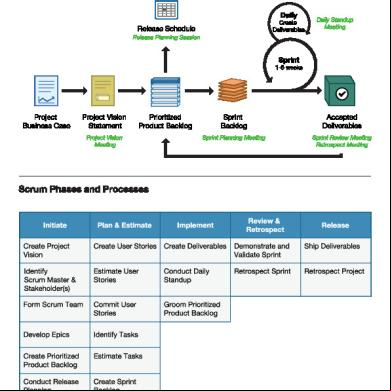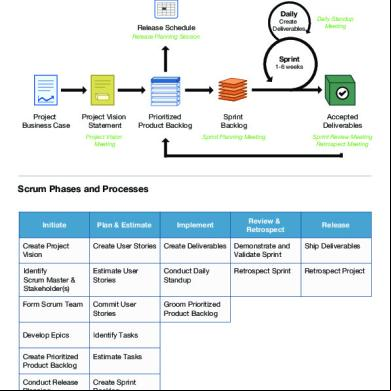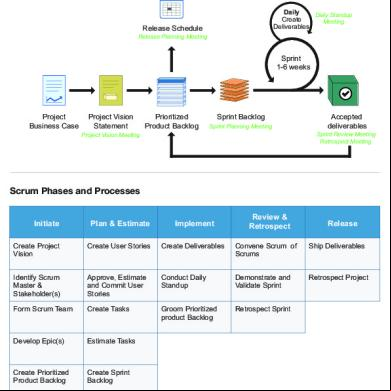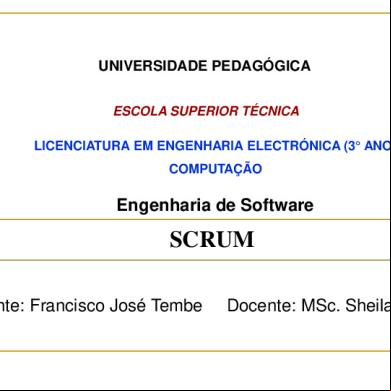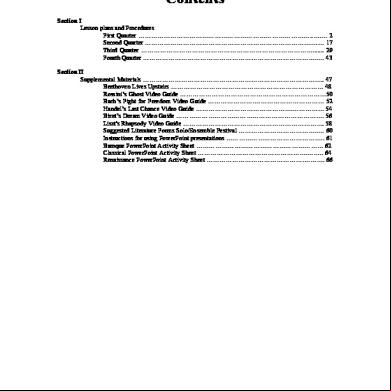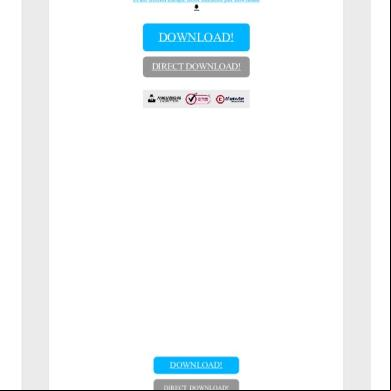Scrum Process Chart (1) (2) 1x5t5i
This document was ed by and they confirmed that they have the permission to share it. If you are author or own the copyright of this book, please report to us by using this report form. Report 3b7i
Overview 3e4r5l
& View Scrum Process Chart (1) (2) as PDF for free.
More details w3441
- Words: 810
- Pages: 2
Process Chart Scrum Flow
Daily
Create Deliverables
Release Schedule
Daily Standup Meeting
Release Planning Session
Sprint
1-6 weeks
Project Business Case
Project Vision Statement
Prioritized Product Backlog
Project Vision Meeting
Sprint Backlog
Accepted Deliverables
Sprint Planning Meeting
Sprint Review Meeting Retrospect Meeting
Scrum Phases and Processes
Initiate
Review & Retrospect
Plan & Estimate
Implement
Create Project Vision
Create Stories
Create Deliverables
Demonstrate and Validate Sprint
Ship Deliverables
Identify Scrum Master & Stakeholder(s)
Estimate Stories
Conduct Daily Standup
Retrospect Sprint
Retrospect Project
Form Scrum Team
Commit Stories
Groom Prioritized Product Backlog
Develop Epics
Identify Tasks
Create Prioritized Product Backlog
Estimate Tasks
Conduct Release Planning
Create Sprint Backlog
© 2017 VMEdu, Inc.
Release
V4
SCRUM ON A PAGE SCRUM PRINCIPLES Empirical Process Control Scrum prescribes making decisions based on observation and experimentation rather than detailed upfront planning.
ROLES
ARTIFACTS
CORE:
Project Vision Statement
Project Vision Meeting
Product Owner
Explains the business need the project is intended to meet and should focus on the problem rather than the solution.
Stakeholders meet to identify the business context, business requirements, and stakeholder expectations in order to develop an effective Project Vision Statement.
Prioritized Product Backlog
Release Planning Meeting
A prioritized list of requirements that, when turned into potentially shippable product functionality, will deliver the Project Vision. Owned by the Product Owner.
The purpose of this meeting it to develop a Release Plan which defines when various sets of usable functionality or products will be delivered to the customer.
Scrum believes that today’s workers have much more knowledge to offer than just their technical expertise and that they deliver greater value when self-organized.
Defines the Project Vision and Release Schedule as the “Voice of the Customer” • Defines customer requirements in the form of Epics/ Stories and clarifies these requirements for team • Prioritizes items on the Product Backlog according to business value • Provides Acceptance/Done Criteria and inspects deliverable(s) to validate them
Collaboration
Scrum Master
Sprint Goal
Ensures that Scrum processes are correctly followed by all Scrum Core Team , including the Product Owner • Ensures that an ideal project environment exists for the Scrum Team to successfully complete Sprints • Oversees Release Planning Sessions and convenes other meetings • Acts as a servant-leader that helps motivate and coach the team
Proposed by the Product Owner and accepted by the team, it is a one sentence aim for the current Sprint.
Self-organization
In Scrum, product development is a shared value-creation process that needs all the stakeholders working and interacting together to deliver the greatest value.
Value-based Prioritization Delivering the greatest value in the shortest amount of time requires prioritization and selection of what could be done from what should be done.
Time-boxing Time is treated as a limiting constraint and time-boxing is used as the rhythm to which all stakeholders work and contribute.
•
1 2 3 4
•
Sprint Backlog A list of items the Scrum Team commits to execute in the Sprint. Any risk mitigating activities are also included as tasks in the Sprint Backlog.
Impediment Log
Scrum Team Typically a small team of 6-10 with no further sub-division of teams • Cross-functional and self-organizing, the Scrum Team enjoys complete autonomy during a Sprint • are generalists across domains and specialists in at least on area • Responsibility of the work lies with the whole team
Impediments or obstacles encountered by the team should be formally recorded by the Scrum Master in an Impediment Log.
•
Iterative Development The customer may not always be able to define very concrete requirements. The iterative model is more flexible in accommodating changing requirements.
MEETINGS
$
NON-CORE ROLE:
Product Increment The potentially shippable deliverable of the team at the end of each Sprint that satisfies the Acceptance and Done Criteria.
Sprint Planning Meeting The primary output of this meeting is the Sprint Backlog. Task Planning and Task Estimation are accomplished during Sprint Planning. Time-boxed to 8 hours for a 1 month Sprint. 3
2
1
Daily Standup Meeting Short, daily meeting time-boxed to 15 minutes. Each Scrum Team member answers the following three questions: • What have I done since the last meeting? • What do I plan to do before the next me • What impediments or obstacles (if any) am I currently facing?
Sprint Review Meeting The Scrum Team presents the completed Sprint deliverables to the Product Owner who either accepts or rejects them based on the defined Acceptance and Done Criteria. Time-boxed to 4 hours for a 1 month Sprint.
Retrospect Sprint Meeting Stakeholders
Team discuss what went well during the previous Sprint and what did not go well, the goal being to learn and make improvements in the Sprints to follow. Time-boxed to 4 hours for a 1 month Sprint.
Customers • s • Sponsors •
Vendors Scrum Guidance Body © 2017 VMEdu, Inc.
v4
Daily
Create Deliverables
Release Schedule
Daily Standup Meeting
Release Planning Session
Sprint
1-6 weeks
Project Business Case
Project Vision Statement
Prioritized Product Backlog
Project Vision Meeting
Sprint Backlog
Accepted Deliverables
Sprint Planning Meeting
Sprint Review Meeting Retrospect Meeting
Scrum Phases and Processes
Initiate
Review & Retrospect
Plan & Estimate
Implement
Create Project Vision
Create Stories
Create Deliverables
Demonstrate and Validate Sprint
Ship Deliverables
Identify Scrum Master & Stakeholder(s)
Estimate Stories
Conduct Daily Standup
Retrospect Sprint
Retrospect Project
Form Scrum Team
Commit Stories
Groom Prioritized Product Backlog
Develop Epics
Identify Tasks
Create Prioritized Product Backlog
Estimate Tasks
Conduct Release Planning
Create Sprint Backlog
© 2017 VMEdu, Inc.
Release
V4
SCRUM ON A PAGE SCRUM PRINCIPLES Empirical Process Control Scrum prescribes making decisions based on observation and experimentation rather than detailed upfront planning.
ROLES
ARTIFACTS
CORE:
Project Vision Statement
Project Vision Meeting
Product Owner
Explains the business need the project is intended to meet and should focus on the problem rather than the solution.
Stakeholders meet to identify the business context, business requirements, and stakeholder expectations in order to develop an effective Project Vision Statement.
Prioritized Product Backlog
Release Planning Meeting
A prioritized list of requirements that, when turned into potentially shippable product functionality, will deliver the Project Vision. Owned by the Product Owner.
The purpose of this meeting it to develop a Release Plan which defines when various sets of usable functionality or products will be delivered to the customer.
Scrum believes that today’s workers have much more knowledge to offer than just their technical expertise and that they deliver greater value when self-organized.
Defines the Project Vision and Release Schedule as the “Voice of the Customer” • Defines customer requirements in the form of Epics/ Stories and clarifies these requirements for team • Prioritizes items on the Product Backlog according to business value • Provides Acceptance/Done Criteria and inspects deliverable(s) to validate them
Collaboration
Scrum Master
Sprint Goal
Ensures that Scrum processes are correctly followed by all Scrum Core Team , including the Product Owner • Ensures that an ideal project environment exists for the Scrum Team to successfully complete Sprints • Oversees Release Planning Sessions and convenes other meetings • Acts as a servant-leader that helps motivate and coach the team
Proposed by the Product Owner and accepted by the team, it is a one sentence aim for the current Sprint.
Self-organization
In Scrum, product development is a shared value-creation process that needs all the stakeholders working and interacting together to deliver the greatest value.
Value-based Prioritization Delivering the greatest value in the shortest amount of time requires prioritization and selection of what could be done from what should be done.
Time-boxing Time is treated as a limiting constraint and time-boxing is used as the rhythm to which all stakeholders work and contribute.
•
1 2 3 4
•
Sprint Backlog A list of items the Scrum Team commits to execute in the Sprint. Any risk mitigating activities are also included as tasks in the Sprint Backlog.
Impediment Log
Scrum Team Typically a small team of 6-10 with no further sub-division of teams • Cross-functional and self-organizing, the Scrum Team enjoys complete autonomy during a Sprint • are generalists across domains and specialists in at least on area • Responsibility of the work lies with the whole team
Impediments or obstacles encountered by the team should be formally recorded by the Scrum Master in an Impediment Log.
•
Iterative Development The customer may not always be able to define very concrete requirements. The iterative model is more flexible in accommodating changing requirements.
MEETINGS
$
NON-CORE ROLE:
Product Increment The potentially shippable deliverable of the team at the end of each Sprint that satisfies the Acceptance and Done Criteria.
Sprint Planning Meeting The primary output of this meeting is the Sprint Backlog. Task Planning and Task Estimation are accomplished during Sprint Planning. Time-boxed to 8 hours for a 1 month Sprint. 3
2
1
Daily Standup Meeting Short, daily meeting time-boxed to 15 minutes. Each Scrum Team member answers the following three questions: • What have I done since the last meeting? • What do I plan to do before the next me • What impediments or obstacles (if any) am I currently facing?
Sprint Review Meeting The Scrum Team presents the completed Sprint deliverables to the Product Owner who either accepts or rejects them based on the defined Acceptance and Done Criteria. Time-boxed to 4 hours for a 1 month Sprint.
Retrospect Sprint Meeting Stakeholders
Team discuss what went well during the previous Sprint and what did not go well, the goal being to learn and make improvements in the Sprints to follow. Time-boxed to 4 hours for a 1 month Sprint.
Customers • s • Sponsors •
Vendors Scrum Guidance Body © 2017 VMEdu, Inc.
v4

